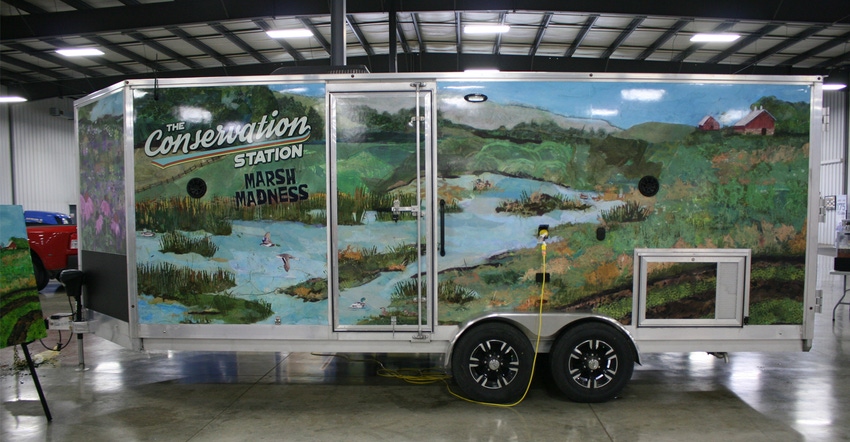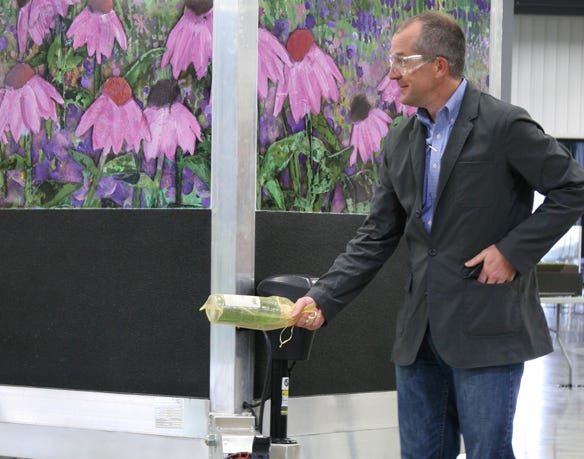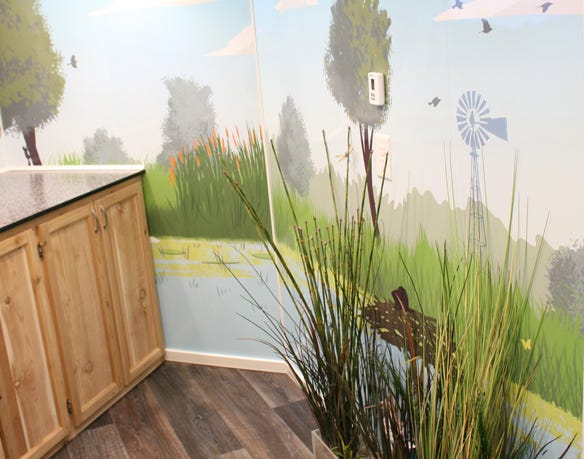
There is a new addition to Iowa Learning Farms' Conservation Station fleet. The new mobile learning station, Marsh Madness, is what ILF refers to as a full sensory immersion learning lab. It features three interactive 3D models of wetlands, along with audio recordings of wetland wildlife, and floor-to-ceiling artwork depicting wetland plants and wildlife — rushes, sedges, horsetail, cattails and various prairie vegetation, as well as animals from shorebirds to amphibians. ILF debuted the new station in late May, making it available for free use for school events, community celebrations, fairs, farmers markets, youth camps, field days and other events.

STATION CHRISTENING: As part of the event launching Iowa Learning Farms’ new Conservation Station, Iowa Secretary of Agriculture Mike Naig christened the new mobile learning lab. It is a collaborative effort among ILF, the Iowa Department of Agriculture and Land Stewardship and other organizations.

"Our vision for the inside is, it would be like people were standing next to a wetland, with some of the sights and sounds of a wetland. We incorporated art — because if we're going to inspire people to make changes on the land, we have to make an emotional appeal," says Jackie Comito, Iowa Learning Farms director. "The overall message is, these wetlands are really important. We don't reach our goals for water quality in Iowa without wetlands in strategic locations. We've lost so many through the decades, and this is an opportunity to teach Iowans how valuable they are."
The station is a collaborative effort among ILF, the Iowa Department of Agriculture and Land Stewardship, the Iowa Department of Natural Resources, the Leopold Center for Sustainable Agriculture, and the Iowa Nutrient Research Center at Iowa State University.
Like ILF's other Conservation Stations, the exterior features a mixed media collage created by Cecelia Comito of Artworks Studio in Carroll, Iowa, along with the help of Staudt.
"We have mixed media collages on our other stations, so we wanted to stay in harmony with that theme, but also have a unique identity," says Ann Staudt, ILF manager and content specialist. "It's built using different layers of paper, pages from books, from farm magazines, and cookbooks. We started with a base layer made from old Wallaces Farmer articles. The upper layers are finer papers, like rice paper, which are painted and pigmented, built with lots of textures."
Interactive learning
This new trailer features three 3D museum-quality models of different wetlands. One model is a prairie pothole, a kind of shallow, ephemeral wetland often found in flat fields in north-central Iowa.

IMMERSIVE EDUCATION: Illustrations inside the trailer are wrapped around the walls and ceiling — including geese flying overhead. Visitors can also see 3D models depicting different wetlands and art showing different vegetation and wildlife, and hear sounds recorded from wetlands.
"We can demonstrate how rain hits the land, and how it moves through the vegetation down to the indentation, the lowest point, and settles there. Then we can demonstrate how, over time, the water will drain and be absorbed into the soil as the pothole dries," Jackie Comito says. "It's showing the most common wetland in the state. The Des Moines lobe used to be just sprinkled with these."
There's also a model of a nutrient-reducing wetland. These wetlands are man-made, and constructed in places where wetlands were likely historically located. They are usually fed by tile drainage water, and they play a key role in denitrification of water that eventually flows into streams or rivers.
The third model is an oxbow. Oxbows occur when water cuts across the landscape at a bend in the river to form a free-standing water body, and serve as habitat for fish species like the Topeka shiner.
Eventually, ILF plans to feature an audiovisual component, with footage of different kinds of wetlands and wildlife.
"On the inside, we debated a lot of ideas, but ended up going with a digital illustration. We worked with a digital illustrator, John Bosley [Bozz Prints] of Des Moines, to create a 360-degree panoramic field, so it looks like you're standing in shallow water, seeing grass and vegetation emerging out of the water on the wall," Staudt says. "You're seeing Des Moines in the background, small towns and ag lands, wildlife that live in and around wetlands. Even the ceiling of the trailer is illustrated. The inside is wrapped, so you look up and see a flock of geese flying overhead with a cloud scene that beautifies the trailer.
"In addition, Laura Comito of Artworks Studio was instrumental in visioning how to lay out the wetland plants and wildlife to create a truly immersive experience. We worked with different wood-carvers who create life-sized sculptures of birds that live in wetlands. We installed a ton of different vegetation in front of the walls," Staudt adds. "You're seeing water and vegetation on the walls, and 3D pieces you can actually touch. You're hearing the sounds of Iowa wetlands as well. Jackie [Comito] created an audio mix of all kinds of animals that live in wetlands. It helps create this whole immersive experience throughout."
About the Author(s)
You May Also Like






